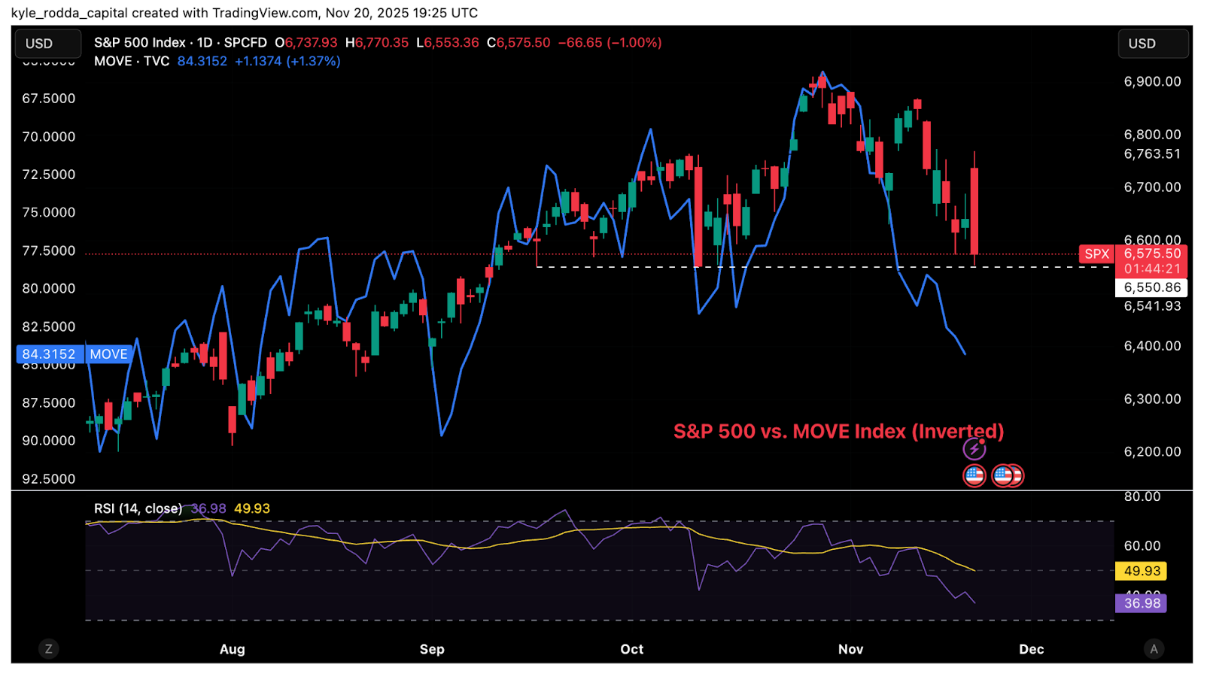Markets in the Fog: Why Rate Uncertainty Still Rules the Narrative
Market volatility remains high as investors look to get further clues on what the Federal Reserve could do at the December meeting
The past few weeks of cross-asset whiplash have had a dominant source: uncertainty about the U.S. interest-rate path. Earnings headlines, AI hype and idiosyncratic stories have mattered at the margins, but the core narrative is still the same: markets are struggling to price the Federal Reserve’s next moves in the absence of timely inflation data, and that fog is widening the distribution of outcomes. Wider distributions mean higher implied volatility, and higher volatility erodes risk appetite.
Rates uncertainty, good earnings and lack of data
A simple way to see the dynamic is through the MOVE index—the “VIX of bonds,” a proxy for rate uncertainty—plotted against U.S. equities. Inverted, MOVE effectively bottomed as the S&P 500 and Nasdaq topped around the last Fed meeting. Since then, traders have repeatedly repriced the near-term path, with the probability of a December cut swinging from roughly a quarter to well above two-thirds and back again. Late last week, cautiously dovish remarks from Fed officials nudged cut odds higher and steadied risk, but they did not resolve the underlying problem. With key inflation releases delayed, we still do not know enough about the current trajectory of prices to have confidence in the policy path.
S&P 500 vs MOVE (inverted) daily chart

Past performance is not a reliable indicator of future results.
The labour picture has offered only partial clarity. The delayed September jobs report was resilient—solid headline payrolls and firmer-than-expected wages—while the unemployment rate ticked up to 4.4% alongside a rise in participation. That mix left both policy doors ajar. The Fed can justify standing pat to guard against inflation risks in a data vacuum, or it can argue for an insurance cut in case slack is building faster than the incomplete data suggest. Until policymakers narrow that range, volatility is likely to stay elevated.
This backdrop has also shaped the market’s reaction to earnings. Corporate results were, by most measures, strong: the S&P 500 delivered double-digit growth overall, and the Magnificent Seven beat again, albeit by a smaller margin than in prior quarters. Even NVIDIA’s impressive print and upbeat guidance could not fully offset nagging questions about the durability of hyperscaler capex and the competitive landscape that lies ahead. With the index still pricing robust earnings growth—20%-plus for the mega-caps and more than 10% in aggregate—equities have room to run if rates volatility subsides, but they also carry asymmetry to the downside should growth expectations slip.
The U.S. calendar this week is not heavy, and much of it is delayed, but stale data can still move markets when information is scarce. PCE inflation, retail sales and GDP revisions will be combed for clues—less for their timeliness than for whether they challenge the benign disinflation narrative that has underpinned hopes for a December move. In a tape this data-starved, second-order signals can punch above their weight if they materially shift rate-cut probabilities.
UK Focus: Autumn Budget and the FTSE
Across the Atlantic, Wednesday’s Autumn Budget puts the UK in focus. The macro starting point is difficult: sluggish growth, inflation that is disinflating but still elevated, and high public borrowing. Having ruled out increases to income tax, National Insurance, VAT and the main corporation tax rate, the government is likely to lean on other levers to close the fiscal gap—think wealth and property taxes, targeted reliefs and sector-specific measures—rather than broad-based hikes. Markets remember the 2022 gilt shock and will scrutinize not only the arithmetic but the coherence of the message. The first read will show up in gilts, then in sterling, and finally in the FTSE. UK equities remain attractively valued relative to global peers, yet persistent macro concerns have capped enthusiasm; how credibly the budget addresses the gap could set the near-term tone across UK assets. Liquidity could be patchy around the U.S. Thanksgiving period, which raises the risk that any missteps are amplified.
Japan: Stimulus, Yen Pressure, and Friday’s Tokyo CPI
Japan offers a different kind of policy mix risk. Rising expectations for fiscal stimulus have weighed on the yen by pulling expected real yields lower and stoking fears of inflation without a matching policy response from the Bank of Japan. Unless the BoJ leans more decisively into normalization, the path of least resistance for JPY remains weaker even as fiscal support buoys domestic equities. Tokyo Core CPI on Friday will be pivotal for the near-term narrative; another above-target print would sustain pressure on the BoJ’s stance and keep intervention chatter alive with USD/JPY near historically sensitive territory.
Gold (and Bitcoin) as Sentiment Thermometers
Gold has been a faithful barometer of the market’s indecision. Despite the recent rise in cut odds, there has been little follow-through in bullion, which has steadied around the $4,050–4,060 area in recent sessions. The signal is not one of panic but of hedged uncertainty: enough macro anxiety to keep a floor under prices, not enough conviction to propel a sustained breakout. Bitcoin’s sharp swings have told a similar story about risk appetite, amplifying shifts in rate expectations and liquidity rather than dictating them.
Taken together, the week ahead is less about a single headline and more about whether the range of plausible outcomes narrows. Any strong hint from the Fed that reduces uncertainty around December would likely bleed into lower rates volatility and a steadier tone for risk assets. Conversely, another week of partial signals and contradictory readings could prolong the chop. In the UK, credibility and consistency will matter as much as the specific tax knobs the Chancellor turns. In Japan, inflation data and BoJ rhetoric will decide whether verbal intervention suffices, or a more forceful policy signal is needed. And in gold, a decisive break from the current range would tell you that conviction—one way or the other—has finally arrived.
Until then, the simplest frame remains the most useful: this is still a rates-led market. When the fog around policy clears, volatility will fall first. Everything else, from AI to earnings to factor rotations, will make more sense after that.
Gold (XAU/USD) daily chart

Past performance is not a reliable indicator of future results.